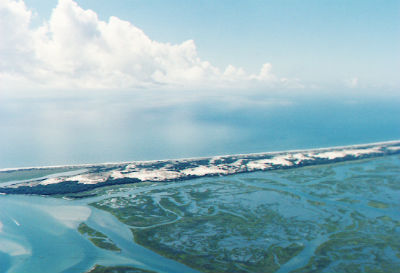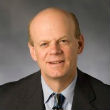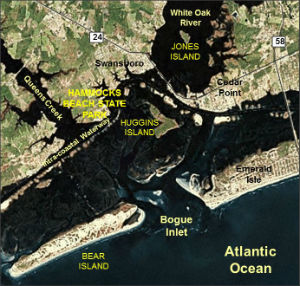This is an updated version of a story that first appeared in the Tideland News
 An aerial view of Bear Island from west to east. Hammocks Beach State Park is currently made up of 30-acres of mainland, Bear Island, Huggins Island and Jones Island. The acquisition would represent about a 25 percent increase in the total size of the park. Photo: Sam Bland |
SWANSBORO — A deal is apparently in the works to settle a long-running court battle and enable the state to purchase 289 mainland acres to add to Hammocks Beach State Park near
Swansboro.
Supporter Spotlight
Nothing is official yet, but several of the people familiar with the negotiations confirmed the basic framework of a possible settlement to a long-standing lawsuit that has embroiled the Hammocks Beach Corporation, the N.C. Board of Education and Harriet Hurst Turner and John Henry Hurst.
If completed, the deal would finally end the lawsuit, and the state and others, including one or more conservation groups and possibly the Marine Corps, would together pay the Turner and Hurst families about $10 million, according to sources.
No settlement has been signed yet, Carol Tingley, the assistant director of the N.C. Division of Parks and Recreation, said yesterday. She declined to talk further about the details of a possible settlement.
Since it would involve the acquisition of property for a state park, any settlement would have to be approved by the N.C. Council of State, which includes Gov. Pat McCrory and his top department heads. The item was pulled from the council’s agenda in May, but the council was expected to consider it when it meets in Raleigh next week. The settlement, however, was not on the agenda that was released yesterday.
State Sen. Harry Brown, R-Onslow, the Republican majority leader and a big supporter of the park, has been working behind the scenes on the acquisition and settlement for a long time, trying to find a solution that would be good for all parties.
Supporter Spotlight
He said Friday he that believes the general framework the Council of State will eventually consider is that solution. “I can’t really see any reason why the Council of State wouldn’t go along with it,” he said. “I’ll be talking to them and I think
several others (legislators) will be, too. There is no question this is an once-in-a-lifetime opportunity to add to the park a piece of property that is unique. I don’t think there is anything else like it along the coast.”
Brown said that he tried to get some money for the acquisition put into a line item in the state budget. “I always try,” he said. “But with money so tight this year, there just wasn’t any way. What I think we can do is use some money that will be available in the state conservation trust funds and combine it with some from other sources.”
 Sen. Henry Brown |
 Bill Holman |
Among the other sources, Brown said, are the Marine Corps, the Conservation Fund and local governments, including Onslow County. The Corps has a fund to buy property to prevent development from encroaching on its base at Camp LeJeune or in airspace it uses for training.
“It needs to get done and we’re going to find a way,” Brown said. “I know the families want to get some of
the purchase money upfront, and I think it will be available.”
Bill Holman, North Carolina state director of The Conservation Fund, said his organization has been
involved in discussions and stands ready to help fund the purchase if the state does not have the full amount of money readily available. The fund would hold the property for addition to the park.
“That’s something we often do if it needs to be done,” Holman said. “We do that for state parks and wildlife areas, if needed. And this I know is one of the top priorities of the state park system.”
Holman certainly hopes it works out. “Hammocks Beach has needed this mainland property on Queens Creek for a long time, really ever since it was created (in 1961),” he said. “It would provide the public a lot more recreational opportunities, would protect water quality in the area and protect a nice piece of habitat.”
The land, which has been used for camping over the years, isn’t “pristine,” Holman said, but contains wetlands, “beautiful live oak trees and loblolly pines and is really just a ‘piece of heaven.’
“There would,” he added, “be opportunities for significant restoration of natural habitat,” as well as enhanced opportunities for public enjoyment of the park.
David Pearson, president of Friends of the Hammocks and Bear Island, the park’s support group, has been deeply involved in the effort for years. He believes the addition of the land would be a great benefit to the public.
“There is no question the possibilities for education and recreation, regional boat ramps, camp sites and an education center are endless,” he has said. “There are possibilities for hatcheries, for oysters, for red drum. The potential economic impacts through increased visitation to the area are tremendous.”
 The addition of the large tract would make the park unique in that |
The addition of the large tract, Pearson said, would make the park unique, in that it would encompass the entire coastal habitat, from the mainland, with bluff forest 35 feet above sea level, through the estuary to the barrier islands.
It also would ensure better protection of the waters, which are classified as Outstanding Resource Waters, the state’s highest classification, by ensuring that nearly 300 acres remain largely undeveloped.
The park is currently made of four different areas: the 30-acre mainland, which is the hub and home of the visitors’ center and ferry dock; Bear Island, an 892-acre largely unspoiled barrier island with a ferry landing, an ocean beach with lifeguards and a restroom and concession facility; Huggins Island, a 225-acre maritime island, home to a historic Civil War battery, at the mouth of the White Oak River in Bogue Inlet; and 23-acre Jones Island, seven miles northeast of Bear Island at the mouth of White Oak. The acquisition would represent about a 25 percent increase in the total size of the park.
The teachers association in the 1950s established the Hammocks Beach Corp. to manage the property in trust for its members. The property deed stated that if it couldn’t manage the property properly, the corporation could transfer the land to the N.C. Board of Education, but that if the board turned it down, it would go to the Hurst and Sharpe families.
The recent legal history began in 2006, when the Hurst heirs sued the corporation, claiming it had failed to properly administer the trust, and sought the return of the 289 acres to the family.
 More land could mean more opportunities for educational programs, like the one pictured above, as well as regional boat ramps, camp sites and fisheries. It would also help protect water quality by ensuring that nearly 300 acres remain largely undeveloped. Photo: Hammocks Beach State Park |
In October 2010, a judge in Wake County Superior Court removed the corporation as trustee. But in early January 2011, the same court asked the state education board if it wanted the land. Although it had previously rejected the
trusteeship twice, the board then said it would accept it, a move that could have cleared the way for the land to become part of the state park.
However, Harriet Hurst Turner and John H. Hurst, heirs of John L. Hurst, appealed, and the state Court of Appeals placed a temporary stay on the lower court’s ruling, citing the board of education’s previous decisions not to accept the property.
Because the appeals court ruling was unanimous, there was no automatic right of review by the N.C. Supreme Court. However, state Attorney General Roy Cooper, on behalf of the education board, filed a petition for that review, and the Supreme Court accepted it. The court hasn’t yet heard the case.
Sources told the Tideland News recently that after years of legal wrangling, neither side in the case felt confident of ultimate victory, and that led to intense desire and strong efforts to reach an agreement that would benefit the park and the families.
The families’ attorney did not return a phone message seeking comment on the possible settlement.







